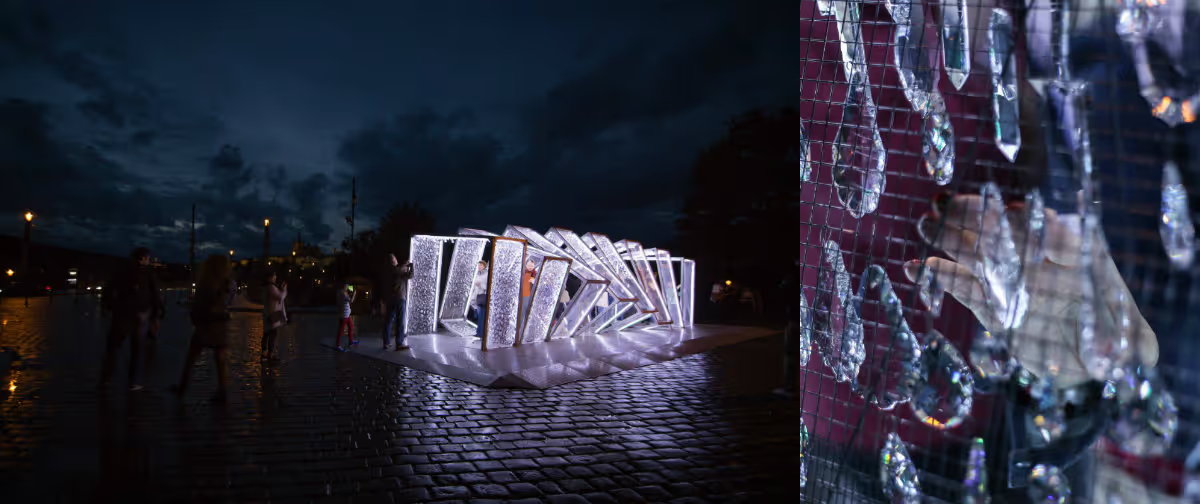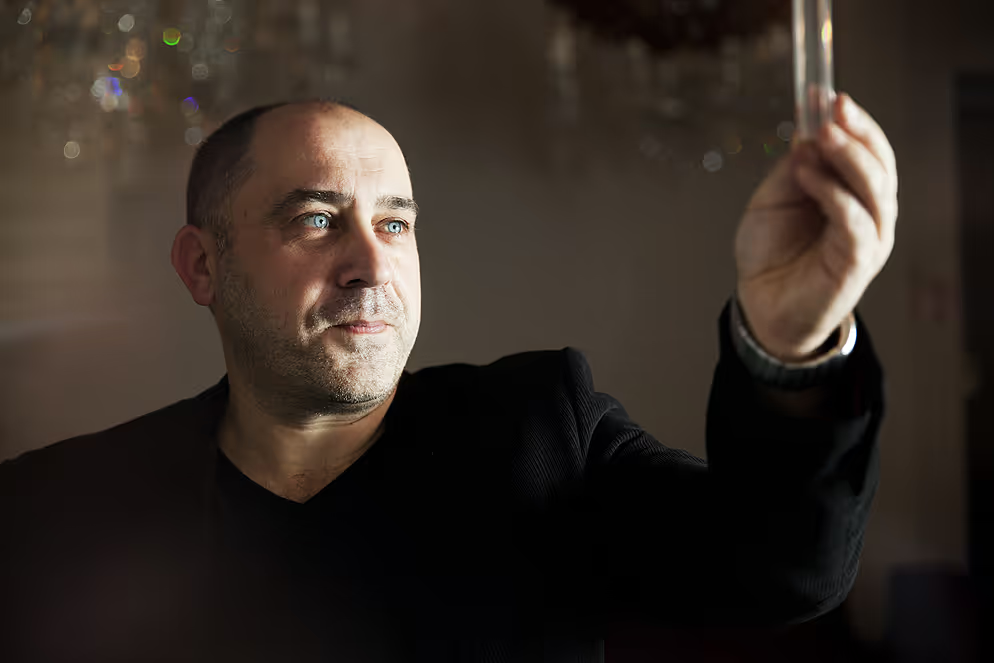► českou verzi rozhovoru najdete zde
What made you employ organic shapes for your Muutos collection?
In our subsidiary in Desná, we have large archives of old metal molds. Looking at thousands of these molds, I thought about transforming them into new shapes. At the beginning, it did not come to my mind that the old molds would deform over time and therefore significantly change the shape of new products. These deformations actually create décor which a new mold would never show.
How did you proceed? Did you transform the original molds?
Muutos is a transformation of old historic molds into new shapes. Some molds are sixty or even eighty years old. They show imperfections and deformations due to their age. Such molds help me come up with atypical structures. I take the semi-finished product and further shape it, remodel and magnify to bring the atypical structures out. The original decor regularity is thus invaded by irregular structures, which enhance the optical qualities of the glass mass. The original shape is only vaguely present there.
Thanks to the new approach to shaping, the glass mass grows in the mold, is it so?
Yes, in the deformation. Each piece is an original of its sort. It depends on how much gather you use, how you blow it, how you apply heat and where exactly you start cooling. It is interesting to experiment with harder molten glass, such as opal, which will not allow for too expressive shaping of structures. It was only when I first started playing with glass that I realized what glass can do and how you can shape it.

Muutos and their intruder like structures.
You mentioned alternative molten glass. Your company traditionally uses the Czech crystal, but obviously you use other materials, too.
My basic line is in 7% lead crystal. I wanted to add black colour and therefore we picked a special molten glass type called Black Hyalit. The colour is actually dark purple, but at first sight it looks black. At places, where you blow into the structure, you get unique tones of black and purple. We will also have pink objects and a collection with water opal (semi-transparent opal).
How do you colour your molten glass?
Each type of molten glass has its exact composition. Whatever you add will impact the final colour. We cooperate with Jarda Švácha, the number one expert in the Czech Republic in composing and testing new colour combinations. We are, however, able to develop and mix exactly the colour our client asks for.
Can you still experiment with glass colour or everything has already been made?
I think one can still experiment. The client will ask us for a certain colour and we will try to mix exactly the tone they ask for.
You often design lights for big space, where your work must match other designs. Architects and investors must be thrilled about your knowledge and experience.
Most of them appreciate companies which offer them good services. Some firms may also be good, but their technology background and services are not as good as ours.
What else did you need to succeed in the competition of other glassmakers?
We must be humble. Humility is extremely important, because you cooperate with an architect who designed the project with a certain vision. It would be counterproductive to try to impose ideas which run counter their own vision. We are proud of our distinctive designs at places where we had a free hand and the client expected us to be active in the design phase. On the other hand, we have equally interesting projects where our light objects, even ten meters high, got incorporated into the interior so well that you hardly even notice it. It happens that the given space is so packed with designer objects that adding a major light would not be right because it would compete strongly with the already existing art and design there.
I guess tradition is very important for your clients…
I prefer not to speak about tradition, of course, we have a long tradition, but some people may perceive it as being stuck with tradition thus unable to grow further. But we do grow – we keep developing and moving forward.
What new do you have up in your sleeve?
In a new special programme called Stardust we process waste from pressing the raw material for cutting small stones. We use special foils to glue it to fabrics. The glued dust hardens the fabric and it shapes nicely into various organic shapes. With the help of special LED sources we turn these objects into lights which give absolutely unique light effects.
Obviously, Preciosa can now take many different directions.
That is right, but we have always striven to stick to our flagship – the most significant element or material – and that is the cut crystal for us, or structures which derives from the cut crystal. Preciosa and Swarovski are the top world producers of high quality cut crystal.

„Each piece is an original," describes Jaroslav Bejvl his Muutos collection.
Lights are not about glass only. Which material do you use for the structure and the hanging system?
It is an interesting issue. We have designed and built a special furnace to shape Plexiglas and materials based on Plexiglas. If you use Plexiglas for the construction of the lamp, it will look as if made 100% from glass. There is not a single piece of metal there but some support strings.
Metal is no longer popular?
Our clients want modern lights which are made by a glass company. They expect high quality materials and metal bothers them, because it can cast shades. Our clients want and expect pure glass.
Still, you cannot avoid metals. Which metals do you prefer?
We use aluminium, aluminium profiles, sheet metal, and casts. With big objects, weight matters a lot. Architects like it, because the lighter the object the cheaper the support structure. Instead of a robust light weighing five tons, we can offer a one tone object with equally hight visual quality.
People´s minds are probably set to await glass when we say - a lamp. But instead of “glass” we see something else, glittery but different. And your brain calls for help.
Maybe. We made a lamp by wrapping a glass chandelier into an exquisite fabric which covered the structure and you could barely see what was inside. People did not get the idea, the hyperbole, the fact that the fabric can be equal to glass. I hope our Stardust programme will be perceived more positively.
It seems that Preciosa is set in people´s minds exclusively as a glass making factory.
Yes, you are right. Preciosa is glass.
During the Signal festival, you installed an object called Crystallation outside the Rudolfinum concert hall in Prague. Did you design it just for the festival?
Yes, I did. Interactive installations which you can enter or otherwise interact with, have become very popular. We designed a phased motion of a square, which resulted in a light tunnel which people could not only enter but also decorate with crystal pendants they bought for a symbolic price. The income will be used to help finance next year’s Signal festival.
Did you use tapes to light the installation?
We used waterproof and programmed LED tapes to repeat sequences of white light and changing colours. That´s we were able to demonstrate how crystal interacts with light colours.

Crystallation during the 2nd Signal festival outside the Rudolfinum concert hall, Prague

Interaction of people, light and glass, Crystallation
Lights keep developing… How is it with programming their features?
This is both an interesting as well as important issue. Light helps us feel good. It contributes to certain atmosphere and changes the interior as needed to serve the immediate needs or activities. The current trend is to combine more types of light in one space. You can play with lights and make it respond to your needs. You can see this trend reflected in lights themselves. Some objects now integrate more sources of light because people want more freedom in their play with light. A lamp may be a mere decoration of your living room, which is nice, makes good atmosphere, but fails to meet the hygienic norms for lightning. It may have, however, a second source of intense light thus complying with the strict hygienic norms.
It sounds like mutants …
No, these are multifunctional objects. The light in the lamp mutates to a certain extent, you are right.
What type of light do you personally prefer?
It is a bit of a problem. My most favourite bright colour is black, so...
So the best place to be is a pantry without any lights? (laughing)
At home, we have plenty of light elements and artefacts, which are scattered around all rooms, but we have no central source of light. We have special lights all over the place, some are on, some are off, or they shine in various combinations. It depends on our mood and immediate needs. My approach is by large functional.
Theoreticians say that the best light is the one which is closest to sunlight.
The standard is 2700 kelvins, it means slightly yellowish light. Some time ago I visited a client in India and we tried this standard with him, too. He was strictly against it saying, that 4000 is a must, he wanted it white, almost sterile. It is about people´s preferences.
So the colour of light by large depends on it source?
Yes, and for us it is very important to take into consideration colour and intensity because our lead crystal requires clear light. If we used wrong colour of light, crystal would visually lose its quality. Wrongly chosen colour of source could degrade the quality of cut as well as the material used. That is why we built our own light lab. A unique material requires unique approach to light.
Can you give me an example?
Cristal does not do well with yellow light. On the other hand, light blue light will bring its colour up and highlight the quality of its cut. At the very beginning of our production, however, our ancestors used candles as sources of light.
How do you think your space will be lit in three years from now?
Maybe the nano world will become reality. We have already started using nano-technology in our factory. We have developed special paint. We can now coat crystal with special coating which is absolutely invisible, does not reduce its optical quality, but protects the final product from dust and other dirt. It is equally important in both interior as well as exterior use. If you hang a traditional chandelier over your dining table, you will have to dust it every three months. Our technology is rather expensive, but those, who appreciate it and can afford it, can get a turnkey solution from us.
Dusting a traditional chandelier with pendants does not sound like fun…
That´s why I don´t want anything like that at home… (laughing). Actually, anything hanging from the ceiling would make me nervous. But I like designing such objects. It is nice to have something hanging off your ceiling. It is as if lights levitated in the space.


%20(2)%20kopie.jpg)

